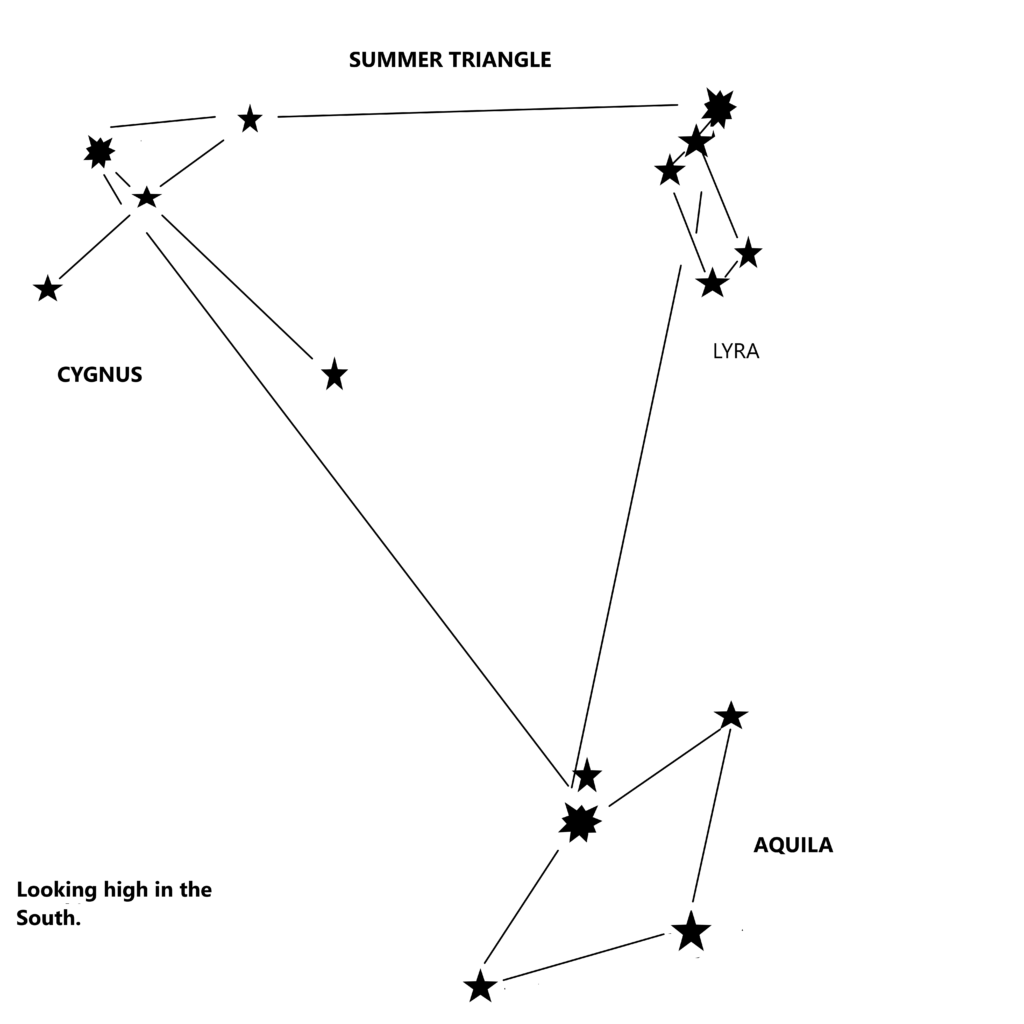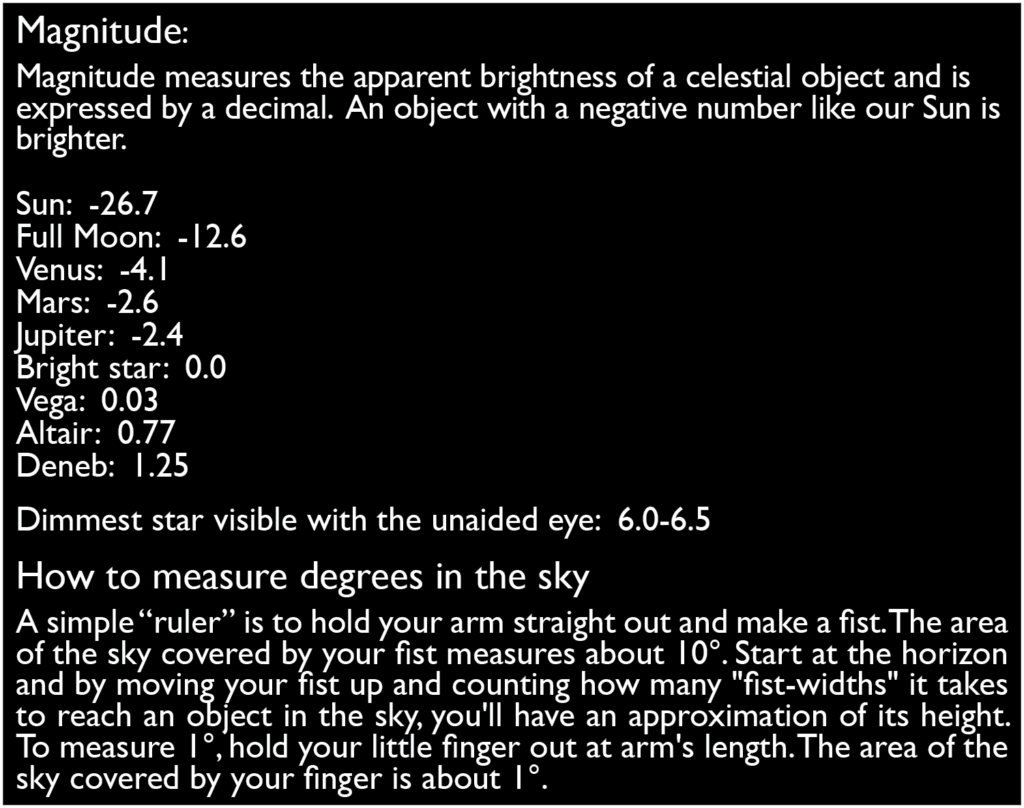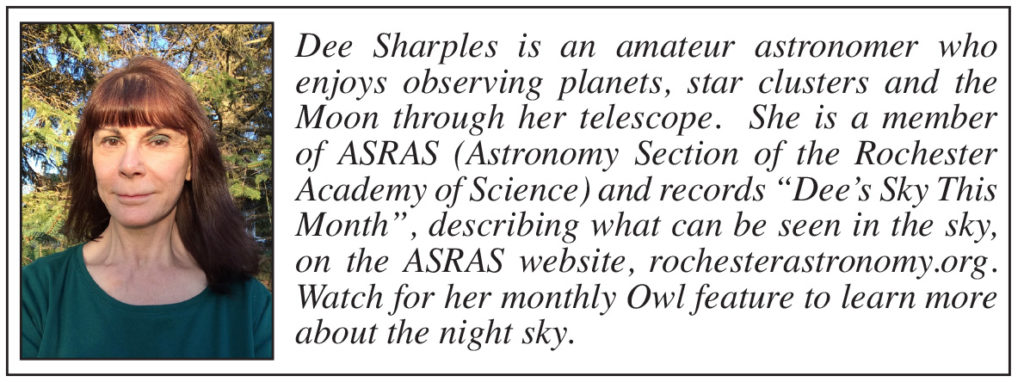The Night Sky-The Summer Triangle
- By Dee Sharples –
The Summer Triangle is an asterism you can see in the night sky in October. An asterism is a prominent pattern of stars resembling an object. In this case, three bright stars can be seen looking like a giant triangle or, using your imagination, a giant slice of pizza.

The brightest of the trio is Vega, a star in the constellation Lyra the Lyre. Vega will be the first star of the triangle that you’ll spot as the sky darkens. Face south, and look high above the horizon and slightly southwest and you’re sure to see it shining brightly at magnitude 0.03. Vega lies about 23 light years from the sun. (A light year is a unit of distance used in astronomy equivalent to the distance light travels in one year – almost 6 trillion miles!) If you were in a spaceship that could travel at the unimaginably fast speed of light, it would take you 23 years to reach Vega.
Almost straight up, you’ll see Deneb, the second star that makes up the base of the triangle. Deneb represents the tail of the swan in the constellation Cygnus the Swan. Deneb is the dimmest at magnitude 1.25 and lies some 2,600 light years from our sun.
The third star Altair in the constellation Aquila the Eagle is below these two and represents the point of the triangle. Altair shines at magnitude 0.77 and is 16 light years away.

Jupiter is still a show piece in the evening sky. It shines brilliantly looking like a magnitude -2.4 star about 30 degrees above the southern horizon at sunset. Jupiter won’t be in our evening sky much longer and by the end of the month, the planet will set in the west about 10:00 PM.
Mars, many times smaller than Jupiter will outshine the giant planet this month. Mars will rise in the east around 8:00 PM at magnitude -2.6 looking like a bright star with a reddish hue. Mars reaches its closest point to Earth on October 6 when it will be only 38.1 million miles away.
However, no other planet in our solar system can outshine Venus. If you’re an early riser, so is Venus this month. After 4:00 AM look for it in the eastern sky, sparkling at a brilliant magnitude -4.1.
Neptune is the 8th and last planet in our solar system and the farthest from the sun at 2.8 billion miles. The planet is in our southeastern night sky right now, but it’s the only planet not visible to the naked eye.
Its atmosphere is made up of hydrogen, helium and methane – the frozen methane in its clouds is what gives the planet a blue color. One of the two ice giant planets, Neptune is four times wider than Earth and has winds of 1,200 mph. A day on Neptune is short, only 16 hours long, but its year, the length of time it takes to travel once around our sun, is 165 Earth years. The only spacecraft to fly past the planet was Voyager 2 in 1989 on its way out of the solar system. It gave us our first close-up look at the planet and Triton, the largest of Neptune’s 14 known moons.
Shortly after I began observing through my telescope, Neptune was going to be in the night sky near some bright stars. Using those bright stars as a road map, I “star-hopped” my way to two faint objects – one was the planet Neptune and the other just a faint star. I thought one of the faint dots might have had a bluish tinge, but to confirm which one was the planet, I made a sketch of the stars I could see in the ‘field of view’ through my eyepiece. Since the planets appear to move among the stars which are fixed in the sky as we see them from Earth, by checking the same ‘field of view’ a week later and comparing it to my sketch, I knew exactly which faint dot was Neptune. Now definitely looking bluish, Neptune had moved to a different location among those stars. What a thrill it was to realize I was looking at a planet, billions of miles away, from my own backyard!
Strasenburgh Planetarium
Public observing on Saturday nights from the roof of Strasenburgh Planetarium has been canceled until further notice. For updates go to: rochesterastronomy.org.
Once viewing resumes, observation information is available at:
www.rochesterastronomy.org/the-strasenburgh-scope/.
